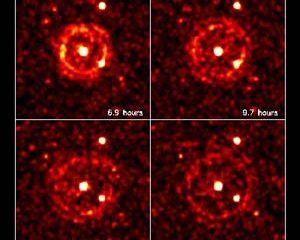This area deals with the fundamental laws and building blocks of nature and how they interact, the properties and the behavior of matter, and research into space and time and their structures.
innovations-report provides in-depth reports and articles on subjects such as astrophysics, laser technologies, nuclear, quantum, particle and solid-state physics, nanotechnologies, planetary research and findings (Mars, Venus) and developments related to the Hubble Telescope.

On Friday the 30th, during the XLII international winter meeting on nuclear physics at Bormio, the first results will be announced of Finuda experiment (Nuclear Physics at Daphne), settled in Frascati at Infn National Laboratories.
Planned and made operating by a group of about forty physicists from Universities and Infn Sites of Bari, Brescia, Frascati, Pavia, Torino and Trieste, Finuda is devoted to the study of hypernuclei: nuclei composed by three different kinds of particles rather the

ESA’s X-ray observatory, XMM-Newton, has imaged a spectacular set of rings which appear to expand, with a speed a thousand times faster than that of light, around the point in the sky where a powerful gamma-ray explosion took place in early December. This is the first time that such a fascinating event, called an `echo’, has been seen in X-ray wavelengths.
This echo forms when the powerful radiation of a gamma-ray burst, coming from far away, crosses a slab of dust in our Galaxy and is sca

Rosetta is scheduled to be launched on board an Ariane-5 rocket on 26 February from Kourou, French Guiana.
Originally timed to begin about a year ago, Rosetta’s journey had to be postponed, as a precaution, following the failure of a different version of Ariane-5 in December 2002. This will be the first mission to orbit and land on a comet, one of the icy bodies that travel throughout the Solar System and develop a characteristic tail when they approach the Sun.
This del

An international team of physicists has provided the best evidence to date of the existence of a new form of atomic matter, dubbed the “pentaquark.” The research team confirmed the existence of pentaquarks by using a different approach that greatly increased the rate of detection compared to previous experiments. The results are published as the cover story in today’s issue of the journal Physical Review Letters.
“The latest, and most conclusive evidence of this five-quark particle — the ‘pe

To carry out simultaneuos observations with several telescopes and transform the combined data into pictures from distant galaxies has so far been a cumbersome procedure which often has taken a long time.
Now a breakthrough has been achieved by way of the installation of optical fibre links between the observatories and the universities who have access to the national and international research networks.
On Thursday 15 January 2004, the first e-VLBI experiment took place between O

Like a doctor trying to understand an elderly patient’s sudden demise, astronomers have obtained the most detailed observations ever of an old but otherwise normal massive star just before and after its life ended in a spectacular supernova explosion.
Imaged by the Gemini Observatory and Hubble Space Telescope (HST) less than a year prior to the gigantic explosion, the star is located in the nearby galaxy M-74 in the constellation of Pisces. These observations allowed a team of European